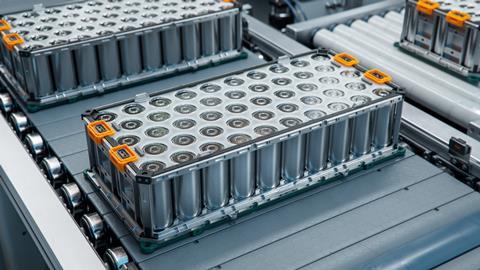The growing risks from the increased use of lithium-ion batteries across the world has left employers, manufacturers, transport hubs and regulators urgently seeking solutions.
Today, Lithium-ion batteries are used to power everything from mobile phones to fork lift trucks and are playing an increasingly common part of the renewables industry as they are used to store excess solar and wind energy.
However, they come with risks, with lithium-ion battery fires killing increasing numbers of people as e-bikes and e-scooters suffer battery malfunctions and go into thermal runaway.

In July a lithium battery factory in South Korea suffered a major fire which left 23 workers dead and authorities in the country looking to impose strict rules around the safety of facilities which manufacture or use lithium battery systems.
In the UK, the recent King’s Speech announced the introduction of a new Bill which will look to implement strict safety rules for lithium-ion battery use.
“The escalating trend in fire-related claims, particularly fuelled by lithium-ion battery-powered devices, is a considerable concern.”
The Product Safety and Metrology Bill in part aims to address the fire risk associated with e-bikes and lithium-ion batteries and clarify legal responsibilities for those supplying products, including online marketplaces. The Bill should also enhance compliance and enforcement measures.
Alison Williams, managing director at Prestige Underwriting said: “The escalating trend in fire-related claims, particularly fuelled by lithium-ion battery-powered devices, is a considerable concern.
“Legislative change is urgently needed to reduce the risk.”
What does it mean for businesses?
Lithium expert Divine Obenndip, at broker UIB said the lessons learned from the South Korean fire and incidents across the world tragedy are likely to result in greater international regulation around the production and storage of lithium batteries.
Obenndip, senior risk engineer in UIB’s energy & construction division said while the batteries are not new, the surge in use has highlighted the risks.
“Lithium-ion batteries have been popular for a number of years as a rechargeable battery option,” he explained.
“This has ranged from rechargeable batteries for household use, in mobile phones, tablets and laptops, electric cars, and up to commercial Battery Energy Storage Systems (BESS) ranging from one Megawatt hour to several hundred Megawatt hours in stored energy.”
Despite their widespread use there are a number of potential hazards. The manufacturing process involves not only lithium containing compounds, but other hazardous substances which can lead to serious health problems if not handled correctly.
“Lithium-ion batteries are also a fire and explosion hazard when not handled correctly, and this risk is particularly high during their transport and operation.”
Obenndip continued: “Requiring special training and equipment for the workforce, Lithium-ion batteries are also a fire and explosion hazard when not handled correctly, and this risk is particularly high during their transport and operation.”
He says that fighting any lithium-based fire is “challenging” because the fire needs to be starved of oxygen, and then the temperature needs to be adequately controlled to prevent a recurrence of the thermal runaway. Fires have been known to restart hours after the initial event was extinguished.
“Guidelines for the management of lithium battery risks are still evolving,” he explained. “Airlines require lithium battery devices to be in hand luggage only and limit the size of batteries carried on board the aircraft. Public transport typically prohibits electric scooters being carried.”
Meanwhile, in the UK July has seen organisations such as Transport for London and some NHS Trusts preparing to ban employees from bringing e-bikes to work after an increase in serious fires caused by faulty batteries.
What can risk managers do to tackle the threats?
Madeleine Cavanagh, loss control engineering property technical lead, at Allianz Commercial said risk managers needed to take steps to identify lithium risks and to mitigate the possibility for the batteries to ignite.
She explained: “As an industry it’s important that we educate customers on the wide range of risks presented by Lithium-ion batteries. And it’s not just e-bikes and scooters that need to be considered.”
Cavanagh explained anyone who owns or manages a building or is responsible for personnel should ensure that there is a clear policy around e-bikes and e-scooters. This policy should be communicated to everyone, including employees, tenants, occupiers, visitors, and contractors.
In order to mitigate these risks, companies need to conduct a comprehensive fire risk assessment covering the handling, storage, use and charging of batteries. This assessment should be regularly reviewed and ensure compliance with the Dangerous Substances and Explosive Atmospheres Regulation (DSEAR).
“Batteries should be stored in well-ventilated, cool and dry places to prevent overheating.”
Additionally, thorough training on battery handling and storage, especially for damaged batteries, should be provided. This training should be delivered by competent individuals, documented and include refresher sessions.
“Specific storage conditions are crucial,” Cavanagh added. “Batteries should be stored in well-ventilated, cool and dry places to prevent overheating.
“In residential buildings, landlords should consider external storage facilities for e-scooters and e-bikes to minimise fire risks. Moreover, automatic fire alarms, with smoke and carbon monoxide detection should be installed in areas where batteries are stored or charged.”
Upon arrival, all batteries or products containing batteries should be inspected for signs of damage. Thermographic inspections can be used for bulk deliveries to detect any rise in temperature.
Faulty or damaged batteries should be quarantined in suitable enclosed containers and placed externally away from the main building and essential plant. Suitable and compatible battery chargers, ideally in a separate building or within a fire-rated enclosure should be used.










No comments yet